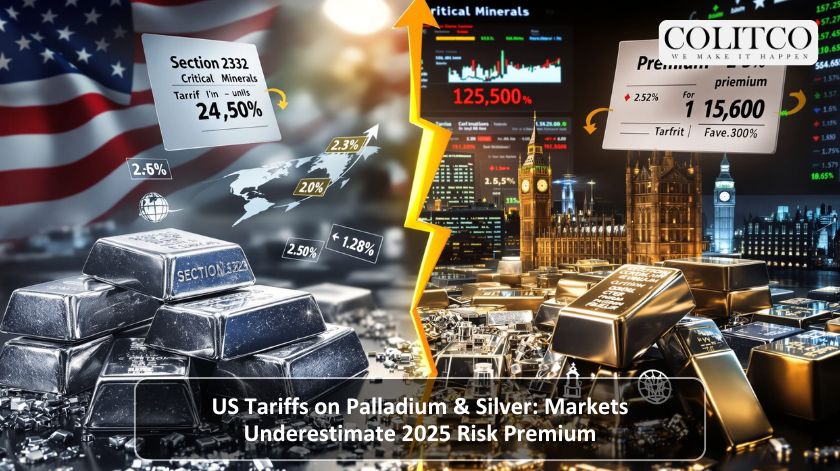The landscape for precious metals trading has shifted dramatically in 2025 as the Trump administration’s comprehensive tariff programme creates unprecedented volatility in global markets. Current US premiums of just 2-3% over international benchmarks appear insufficient given the mounting uncertainties around policy implementation, suggesting markets are significantly underpricing the risk embedded in US tariffs on palladium & silver.
While COMEX exemptions provided temporary relief in April 2025, ongoing reviews and investigations signal that this calm may prove short-lived. Silver’s addition to the critical minerals list in August has triggered a Section 232 review, potentially leading to targeted tariffs of up to 50% by October. Similarly, palladium faces mounting pressure through anti-dumping investigations on Russian supplies, which could exacerbate supply chain disruptions in a market already grappling with geopolitical tensions.
Current Tariff Framework Reshapes Precious Metals Trading
The transformation of US trade policy began with President Trump’s national emergency declaration on 2nd April 2025, addressing what he described as “large and persistent US trade deficits.” This unprecedented action enabled the invocation of the International Emergency Economic Powers Act (IEEPA) to impose a 10% tariff on all imports, with higher rates for 57 countries beginning 9th April.
Average US tariff rates surged from 2.5% to an estimated 27% by April, the highest level since the Smoot-Hawley Tariff Act. However, critical minerals received nuanced treatment, with partial exemptions for certain COMEX-traded forms of palladium, platinum, and silver introduced in April.
These exemptions caused US futures premiums over London spot prices to collapse after earlier surges during the first quarter. Yet the relief proved temporary, as silver’s inclusion in the US critical minerals list on 26th August alongside 53 other materials triggered a comprehensive Section 232 national security review.
The review, expected to conclude by October, could impose targeted tariffs of up to 50% on imports from Mexico and Canada, which supply approximately 50% of US silver. This development has created significant uncertainty for ASX gold miners and international precious metals traders monitoring policy shifts.
Also Read: Gold and Copper in 2025: How ASX, NYSE, and TSXV Companies Are Responding to Global Demand
Silver Market Dynamics: Industrial Demand Meets Supply Constraints
Silver pricing has experienced remarkable volatility, reaching record highs of $38.96 in July amid tariff concerns. The metal’s unique position, with over 50% of demand coming from industrial applications, makes it particularly susceptible to trade policy disruptions.
The World Silver Survey 2025 reports the fifth consecutive annual deficit, totalling approximately 800 million ounces from 2021-2025. This year alone faces a 117.7 million ounce shortfall, driven primarily by industrial demand that continues outpacing mine production.
Solar panel manufacturing represents the largest growth driver, consuming 195.7 million ounces in 2024 with projections indicating demand could double by 2029. Advanced photovoltaic panels require 20-40% more silver than conventional models, while emerging technologies like Samsung’s solid-state batteries could consume up to 1 kilogram per electric vehicle, twenty times current EV levels, starting in 2027.
The supply-demand imbalance becomes more acute when considering that US mines meet only 17% of domestic consumption. Mexico remains the world’s largest silver producer, supplying significant portions of US imports alongside Canada. Potential tariffs on these suppliers could create severe bottlenecks in industrial supply chains while supporting domestic pricing premiums.
India’s silver imports reached 225 million ounces in 2024, indicating robust Eastern demand that could compete with Western markets for available supply. Exchange-traded fund growth has added another dimension to demand, creating competition between financial and industrial users.
| Year | Supply (Moz) | Demand (Moz) | Deficit (Moz) |
| 2024 | ~1,000 | ~1,200 | -200 |
| 2025 | ~1,020 | ~1,138 | -118 |
Source: World Silver Survey 2025
Palladium Faces Russian Supply Disruption Risk
Palladium’s market dynamics present a different set of challenges, with Russia controlling approximately 40% of global mined production. The anti-dumping investigation initiated in August follows petitions from Sibanye-Stillwater and Montana’s GOP delegation, calling for 50% duties on Russian unwrought palladium to counter alleged market manipulation post-2022.
These actions aim to protect US operations like Sibanye-Stillwater’s Montana facilities, which laid off over 600 workers due to low-priced imports. The company’s petition frames tariffs as essential for both job preservation and national security, reducing dependency on adversarial nations.
Palladium prices rose 31% through 2025, though forecasts predict a shift toward surplus conditions. UBS projects a correction to $1,200 per ounce amid recovering South African production, but tariff-induced supply rerouting could maintain elevated volatility regardless of fundamental supply-demand balance.
The automotive industry’s reliance on palladium for catalytic converters creates downstream risks. North American market growth at 8.2% CAGR to 2030 reflects industrial demand tied to vehicle production, making supply disruptions particularly damaging for manufacturers.
Current market forecasts suggest:
| Metal | Current Premium (%) | Tariff Risk (up to %) | 2025 Forecast ($/oz) |
| Silver | 2-3 | 50 | $42-44 |
| Palladium | 2-3 | 50 | $1,200 |
Source: UBS, Citi analysis
COMEX Exemptions: Temporary Relief or Strategic Policy Tool?
The CME Group’s COMEX division processes over 400,000 futures and options contracts daily, making it the world’s most liquid metals exchange. Exemptions granted to certain COMEX-traded forms provided crucial relief during the initial tariff implementation, preventing severe disruptions to price discovery mechanisms.

However, these exemptions remain subject to ongoing reviews. The narrow scope, covering specific contract specifications rather than all precious metals, creates complexity for market participants. Physical delivery requirements and good delivery standards must still be met through approved refiners and depositories within the COMEX system.
Critics highlight that tariffs could decouple US prices from global benchmarks, potentially shifting price discovery from New York to London or Shanghai. A Monetary Metals analysis suggests a 25% duty could spike volatility while eroding COMEX’s traditional role in international price setting.
The implications extend beyond trading floors. Industrial users facing higher costs may accelerate reshoring initiatives or seek substitutes, creating both challenges and opportunities across the mining sector.
Investment Implications and Risk Management Strategies
Professional investors are adapting portfolios to account for increased volatility and potential price dislocations. The underpriced risk premiums create opportunities for those willing to navigate increased complexity in precious metals markets.
Exchange-traded funds offer one approach to gaining exposure while avoiding physical delivery complications. However, fund structures and underlying assets require careful evaluation, as some may be more exposed to tariff impacts than others.
Direct physical ownership through approved dealers provides protection against policy-driven supply disruptions, though storage and insurance costs require consideration. The premium buyers pay over spot prices has widened as dealers factor in increased operational complexity.
Futures and options strategies enable sophisticated investors to profit from volatility while managing downside risk. However, the evolving regulatory environment requires constant monitoring of exemption status and contract specifications.
Australian mining companies with precious metals exposure face mixed impacts. Those with production outside the US may benefit from higher American prices, while companies reliant on US markets could face margin pressure if exemptions are removed.
Geographic diversification becomes increasingly important as trade policies fragment global markets. Investors should monitor developments in alternative trading centres and consider exposure to companies with geographically diverse operations.
Geopolitical Factors Drive Long-term Structural Changes
The tariff programme represents more than temporary trade disputes—it signals fundamental shifts toward supply chain reshoring and reduced dependence on adversarial nations. These changes create lasting implications for precious metals markets.
Russian sanctions and restrictions continue evolving, with palladium particularly vulnerable given Moscow’s dominant market position. Alternative suppliers lack capacity to immediately replace Russian production, creating medium-term supply tightness regardless of demand conditions.
Chinese market dynamics add complexity, as the world’s largest metals consumer adapts to changing trade relationships. China’s strategic minerals stockpiling programmes could compete with Western demand while Beijing develops alternative supply chains excluding US markets.
Critical minerals classification elevates silver and palladium beyond their traditional precious metals status, integrating them into national security frameworks. This shift supports higher structural premiums while increasing government intervention in market mechanisms.
Central banks’ continued gold reserve accumulation, with 95% expecting increases, indirectly supports silver as investors seek exposure across the precious metals complex. The monetary hedge characteristics become more relevant as trade wars threaten currency stability.
Technical Analysis and Price Projections
Current technical indicators suggest silver remains in a strong uptrend despite periodic corrections. The record high of $38.96 established resistance levels that may be tested again as October’s Section 232 decision approaches.
Support levels around $32-34 provide buying opportunities for longer-term investors, while resistance near $40 represents a significant psychological barrier. Breaking above this level could trigger momentum buying toward UBS’s $44 target.
Palladium faces more complex technical signals given supply uncertainties. The $1,200 level identified by UBS represents both technical resistance and fundamental fair value, but geopolitical developments could override traditional analysis.
Volatility measures remain elevated across both metals, reflecting uncertainty around policy outcomes. Options premiums have increased substantially, indicating professional traders are pricing significant potential price moves.
Sector Outlook and Corporate Responses
Mining companies are adapting business models to navigate the new trade environment. Resolution Minerals exemplifies this trend with its focus on US-based critical minerals assets, positioning for domestic supply chain preferences.
Corporate strategies increasingly emphasise geographic diversification and supply chain flexibility. Companies with assets in multiple jurisdictions can capitalise on price differentials while reducing single-country exposure.
Joint ventures between US and international firms may increase as companies seek to comply with domestic sourcing preferences while maintaining global market access. These partnerships could reshape industry structures over coming years.
Investment in domestic processing capabilities represents another trend, as companies seek to capture value-added activities within tariff-protected markets. This reshoring could support employment while reducing import dependence.
Investment Recommendations for 2025
Market participants should prepare for increased volatility as policy uncertainty persists through the remainder of 2025. The October deadline for Section 232 decisions represents a critical inflection point that could determine pricing structures for years ahead.
Professional investors may find opportunities in the options markets, where elevated implied volatilities reflect uncertainty rather than fundamental analysis. However, these strategies require sophisticated risk management and constant monitoring of regulatory developments.
Physical precious metals ownership through approved channels provides protection against supply disruptions, though premiums over spot prices will likely remain elevated. Storage and insurance costs must factor into return calculations.
Australian ASX-listed miners with international exposure could benefit from geographic arbitrage opportunities as price differentials widen between regions. However, operational complexity will increase as companies navigate multiple regulatory frameworks.
The fundamental drivers supporting precious metals remain intact: chronic silver supply deficits, concentrated palladium production, and growing industrial demand from clean energy transitions. Tariff policies add another layer of complexity but don’t alter these underlying trends.
Investors who successfully navigate the evolving trade environment while maintaining exposure to fundamental growth drivers may find significant opportunities in the current dislocation between risk and reward in precious metals markets.
Also Read: Pacgold Limited Reports Strong Gold Drilling Results at Alice River Project
FAQ: US Tariffs on Palladium & Silver
Q: How do US tariffs affect silver and palladium prices?
Tariffs create US-specific premiums by making imports more expensive, potentially increasing costs by 25-50% though exemptions currently mitigate some effects.
Q: Are COMEX-traded metals exempt from tariffs?
Partial exemptions apply to certain forms since April 2025, but these remain under review and could change based on policy developments.
Q: What are the main risks for 2025?
Section 232 reviews and anti-dumping investigations may impose substantial duties, while supply chain disruptions could create shortages affecting both industrial and investment demand.
Q: Which countries face the highest tariff rates?
China faces up to 245% combined tariffs due to retaliatory actions, while Mexico and Canada could see significant levies on silver exports if exemptions are removed.
Q: How should investors position for tariff impacts?
Diversification across geographic regions, consideration of physical versus paper exposure, and monitoring of exemption status changes are essential for managing tariff-related risks.
Q: Will exemptions continue for precious metals?
Current exemptions remain subject to ongoing reviews, with decisions expected by October 2025 that could substantially alter market dynamics.
Q: What sectors benefit from higher precious metals prices?
Domestic miners, recycling companies, and firms with US-based processing capabilities could benefit from higher domestic prices and reduced foreign competition.












